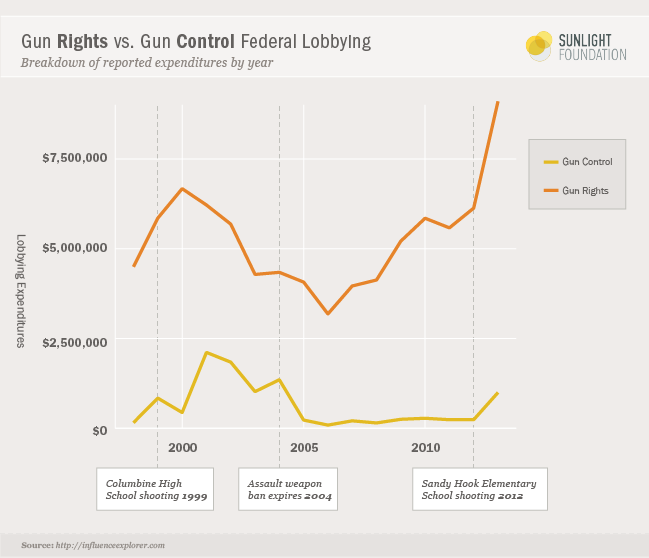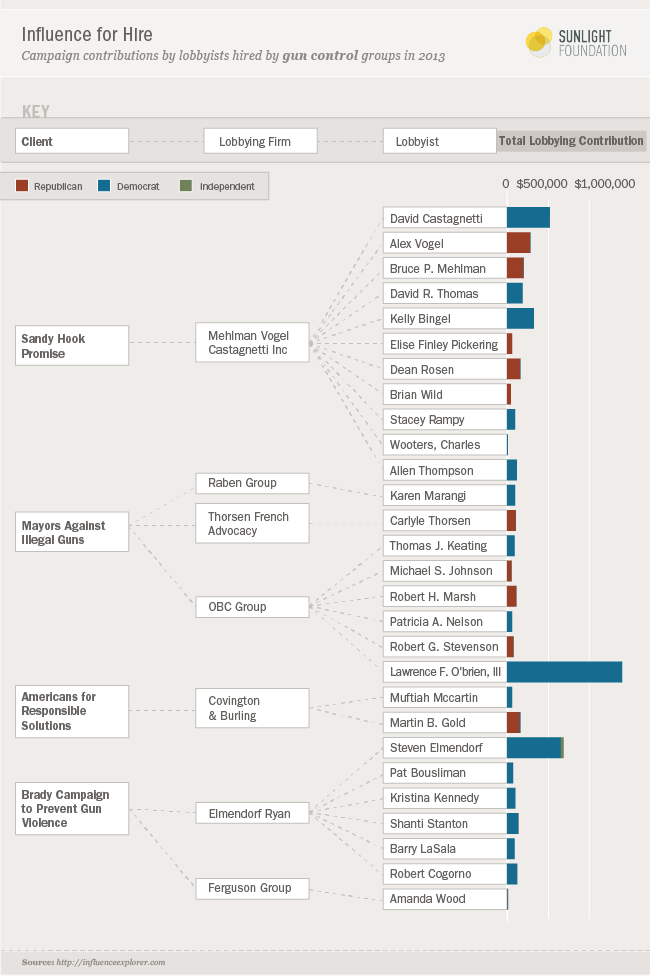Hired guns: K Street revolvers shot blanks against NRA artillery

“In the coming weeks,” he said to people gathered at a prayer vigil mourning the dead, “I’ll use whatever power this office holds to engage my fellow citizens, from law enforcement to mental health professionals, to parents and educators, in an effort aimed at preventing more tragedies like this. Because what choice do we have? We can’t accept events like this as routine.”
With these words, the issue of gun regulation took center stage in Washington for the first time since 2004, when Congress had declined to renew a 10-year-old assault weapon ban. For advocacy groups on both sides of the gun issue, it was also a sign they should staff up. The result: a boon for inside-the-Beltway lobbyists.
Over the past year, gun control groups reported spending five times as much on federal lobbying as they had the previous year: $1.6 million versus $240,000, a review of federal lobbying records shows. That’s the largest amount recorded since 2004. Despite this increase, however, groups on the other side of the debate maintained their enormous advantage: Organizations backing gun rights, such as the National Rifle Association, reported lobbying spending of $12.2 million, more than seven times as much as gun control groups. Even if the amount were adjusted by subtracting the amount reported spent by the National Association for Gun Rights, which is likely inflated because of the way in which that group counts lobbying expenses, gun rights groups reported spending $6.2 million, nearly four times as much as gun control groups.
By year’s end it was the gun rights groups that could claim victory in the nation’s capital. In April, Senate Democrats were unable to garner enough votes to pass legislation that would extend background checks on gun buyers to private sales. All other proposals also died in the Senate. While the situation was different in states such as Colorado, Connecticut, Maryland and New York — all of which approved major gun law overhauls — at the federal level, the status quo reigned.
For gun control advocates, the Washington stalemate came despite a stepped-up campaign that not only saw an increase in the quantity of their lobbying but a fundamental shift in strategy. Much of the increased lobbying spending by gun control groups at the federal level went to hire lions of the Washington lobbyist establishment, big names who have gone through the revolving door from Congress and the executive branch. Their typical clients are Fortune 500 companies and major trade associations, as opposed to clients with an ideological bent. In this, the gun control groups were mirroring their opposition: The NRA has long hired outside lobbyists to supplement its staff.
Overall, gun control groups reported hiring some three dozen lobbyists at eight lobbying firms. For the vast majority, it was the first time they reported lobbying on behalf of a gun control group. Not only do these lobbyists offer direct personal connections to powerful players on the Hill, but many are also generous campaign contributors and fundraisers. Sunlight’s Influence Explorer, which combines federal and state campaign finance records from the Center for Responsive Politics and the National Institute on Money in State Politics, shows that the outside lobbyists hired by gun control groups contributed $7.3 million since 1989 to federal and state campaigns. Just under 64 percent of that went to Democrats.

Steven Elmendorf of Elmendorf Ryan, another major Democratic lobbyist, was hired by the Brady Campaign Against Gun Violence. Described as “one of the leading lobbyists in Washington, DC,” Elmendorf “represents some of the nation’s most important corporations, trade associations and organizations on critical legislative and regulatory issues, helping drive their businesses, build their brands and expand their market shares.” For a dozen years, he served as a senior aide to then-House Democratic Leader Dick Gephardt. He has opened his home for Democratic fundraisers, bundled at least $200,000 for the Democratic Congressional Campaign Committee and personally has contributed more than $731,000.
Not all the gun control hired guns were Democrats. Sandy Hook Promise, a new organization that sprung up after the shootings, signed on Bruce Mehlman of Mehlman Vogel Castagnetti Inc. Mehlman, who served in President George W. Bush’s Commerce Department as an assistant secretary, is described as “widely regarded as an expert in running issue campaigns, managing C-suite associations and developing advanced lobbying strategies that achieve impactful policy outcomes.” Mehlman also serves as host for congressional fundraisers and personally has contributed more than $206,000 to political campaigns.
New type of lobbyist
These for-hire lobbyists overall have a different profile from those who work directly for gun advocacy organizations. For example, Kirsten Rand, a lobbyist for the Violence Policy Center, a small organization that concentrates largely on research, has been a registered lobbyist since at least 1998. She is not listed as giving a single campaign contribution over $200, the threshold amount for itemized donations, and the Violence Policy Center has been her only client.
For Mayors Against Illegal Guns’ Executive Director Mark Glaze, himself a registered lobbyist, increasing staffing power was an obvious choice. “It was about having extra hands and brains at a time when every minute mattered,” he told Sunlight. “[Obama] largely endorsed a set of priorities we’d been promoting for years. When you move to the Hill you just need more smart people to talk to other smart people in congressional offices. So we staffed up on both chambers and both sides.”
Mayors Against Illegal Guns, founded in 2006 by New York City Mayor Michael Bloomberg and other big city mayors, hired 14 outside lobbyists working for four different firms, reporting federal lobbying spending of $1.3 million overall in 2013. While Mayors had hired the Raben Group before — indeed that is Glaze’s former employer — the other firms were new: OB-C Group, home of O’Brien, the JBH Group and Thorsen French Advocacy. All of these groups were on Mayors’ payroll as of the first quarter of the year.
Among the lobbyists hired, in addition to O’Brien, was Thomas J. Keating, also of OB-C Group, who had worked for more than a decade in the sergeant of arms office, most recently as director of police services on Capitol Hill and whose personal campaign contributions are concentrated on Democrats. The connections of others, according to Sunlight’s Lobbying Tracker: Robert H. Marsh worked for former President George W. Bush; Michael S. Johnson was chief of staff to former House Minority Leader Bob Michel, R-Ill.; Nathan J. Miller worked for former Sen. Lincoln Chafee, R-R.I.; Patricia Nelson labored as a Democratic staffer for the House Ways and Means Committee; and Robert G. Stevenson toiled for former Sen. Bill Frist, R-Tenn. Carlyle Thorsen of Thorsen French Advocacy worked as an aide to former House Majority Leader Tom DeLay, R-Texas, as well as for both the House Judiciary Committee and the Justice Department, key for the gun issue. His lobbying disclosure form specifically lists the background check issue as his focus. He was on hire by Mayors through September.
The Brady Campaign Against Gun Violence, originally established in the 1970s as Handgun Control Inc., had for many years conducted all its lobbying in house. However, in February the group took on the firm Elmendorf Ryan, whose team of a half dozen lobbyists, in addition to Elmendorf, all boasted resumes that included Capitol Hill service for Democrats. In March, the group also hired Amanda Wood, then of the Ferguson Group, who had worked for former Sen. Bob Graham, D-Fla. The Brady Campaign maintained ties with Wood after she left for a new firm, Becker and Poliakoff, in October. Overall, the Brady Campaign reported spending $60,000 on federal lobbying.
Two new groups founded after the Sandy Hook shootings also turned to K Street to gain a lobbying presence on Capitol Hill. Americans for Responsible Solutions, founded by former Rep. Gabrielle Giffords, D-Ariz., and her husband, former astronaut Mark Kelly, opened its doors in January — the anniversary of the 2011 Tucson shooting that led to Giffords’ retirement. The group reported spending a total of $55,000 on federal lobbying, all of it to hire the firms Covington & Burling as well as the Majority Group. Covington & Burling was brought on in March but terminated at the end of June. Muftiah McCartin of the firm served as the first woman parliamentarian for Congress and as staff director for the Rules Committee. Her colleague, Martin Gold, is the veteran of several Republican Senate offices and was an adviser to then Majority Leader Sen. Bill Frist, R-Tenn. At the Majority Group, lobbyists include former Rep. Walt Minnick, D-Idaho, who despite his Democratic credentials is an alumnus of the Nixon Administration.
Sandy Hook Promise, a nonprofit group founded in direct reaction to the shootings in Newtown, reported spending $130,000 to hire the firm Mehlman, Vogel, Castegnetti; A total of 12 lobbyists are listed, including Mehlman, who together bring experience from the House, Senate and executive branch on both sides of the aisle. Both of the other name partners are also listed on the disclosure forms: David Castagnetti, who served as chief of staff to Sen. Max Baucus, D-Mont., and Alex Vogel, who served as chief counsel to Frist.
NRA still lobbying top gun
For gun rights groups, the pattern was markedly different. The National Rifle Association not only includes 15 registered lobbyists directly on its payroll, such as long-timer Christopher W. Cox, who serves as executive director of the group’s legislative arm, but it also has been hiring extra help from outside firms since at least 1989. The earliest records are available on Sunlight’s Influence Explorer.
In 2013, the NRA and its legislative arm reported spending a total of $2.5 million on federal lobbying, including the services of 15 lobbyists working for a total of seven firms. To put that in perspective, that’s substantially more than all the gun control groups combined: $1.6 million. The amount that the NRA has reported spending on federal lobbying is also relatively consistent, ranging between $2.1 and $3 million per year since 2009. Firms hired by the NRA and its legislative arm were: Prime Policy Group; Barnes & Thornburg; C2 Group; Cauthen, Forbes, and Williams; Crossroads Strategies; FTI Government Affairs; Greenberg Traurig; and Shockey Scofield Solutions.
Overall, it is a highly seasoned group. Of the outside lobbyists hired by the NRA, only one was new to the issue in 2013: Scott Styles, who began the year at C2 Group before it merged with FTI Consulting, and whose experience includes serving as chief of staff to Rep. Pete Sessions, R-Texas. Longtime lobbyists-for-hire for the NRA include Jeff Forbes, a veteran of former President Bill Clinton’s administration. John Green and G. Stewart Hall of the firm Crossroads Strategies have been on board since the late 1990s. Michael E. Williams of Greenberg Traurig worked as a senior lobbyist for the NRA before joining the law and lobbying firm.
The biggest change in federal lobbying expenditures on the gun rights side of the debate in 2013 came from another group, the National Association for Gun Rights. It reported spending a whopping $5.9 million. However, this figure must be taken with a grain of salt. Founded in 2001, the group, which describes itself as a “no compromise gun group,” says it spends most of its money on communications with members. Political Ad Sleuth shows it has run advertising in several states.
However, after Sandy Hook, the group decided to hire a lobbyist, according to this report by the Center for Responsive Politics (CRP). Christopher Kuper, one of the listed lobbyists, worked for a super PAC supporting libertarian Ron Paul. Lucius O’Dell’s LinkedIn profile lists him as working for the Republican Study Committee of Colorado and the campaign for former Rep. Marilyn Musgrave, R-Colo. The group’s executive vice president, Dudley Brown, told the Center for Responsive Politics that the group includes money targeting members of Congress with issue ads on social media sites — amounts that are not typically included in federal lobbying reports.

